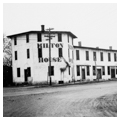Grout, a form of poured concrete, was briefly popular as a building material in the mid-nineteenth century. The town of Milton in Rock County has a particularly large concentration of grout buildings thanks to the arrival in the 1840s of Joseph Goodrich from upstate New York. Although Goodrich did not construct all the grout buildings in Milton, he was responsible for the Milton House and the neighboring Goodrich Blacksmith Shop see RO21. Built in the 1840s, they are the oldest known surviving examples of grout construction. The Carl Gifford House see RO21 of 1868 is unusual because it is composed of grout blocks rather than Goodrich’s solid-wall technique. Several grout structures in Milton were built to store wheat, notably the former John Alexander Wheat Warehouse see RO21. The indented mortar joints between the blocks can be seen beneath the thin coat of stucco.
Goodrich’s material and method received a boost in 1854, when Orson Fowler, the proponent of octagonal houses, visited the Milton House. Fowler was so impressed with grout construction that when he revised his book A Home for All and republished it in 1853, he promoted gravel walls for octagonal buildings.
Several grout houses see FD1 constructed in the early 1850s in Ripon by stonemason Marcellus Pedrick are made of grout blocks that look like dressed stone. For his house now the Ripon Historical Society Museum the blocks walls are yellow in color and resemble the local limestone. The Richard and Phoebe Catlin House see FD1 is unusual in that the blocks imitate brick rather than stone.
Writing Credits
If SAH Archipedia has been useful to you, please consider supporting it.
SAH Archipedia tells the story of the United States through its buildings, landscapes, and cities. This freely available resource empowers the public with authoritative knowledge that deepens their understanding and appreciation of the built environment. But the Society of Architectural Historians, which created SAH Archipedia with University of Virginia Press, needs your support to maintain the high-caliber research, writing, photography, cartography, editing, design, and programming that make SAH Archipedia a trusted online resource available to all who value the history of place, heritage tourism, and learning.




